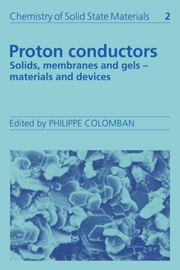Book contents
- Frontmatter
- Contents
- List of contributors
- Preface
- Symbols
- I HYDROGEN BOND AND PROTONIC SPECIES
- 1 The hydrogen bond and chemical parameters favouring proton mobility in solids
- 2 Protonic species and their structures
- 3 Proton conductors: classification and conductivity
- 4 Defects, non-stoichiometry and phase transitions
- 5 Structural studies of proton conductors
- 6 Hydrogen in metals: structure, diffusion and tunnelling
- II MATERIALS: PREPARATION, STRUCTURES AND PROPERTIES
- III PROTON DYNAMICS AND CHARGE TRANSPORT
- IV PROTON DIFFUSION MECHANISMS
- V DEVICES
- Index
1 - The hydrogen bond and chemical parameters favouring proton mobility in solids
Published online by Cambridge University Press: 04 May 2010
- Frontmatter
- Contents
- List of contributors
- Preface
- Symbols
- I HYDROGEN BOND AND PROTONIC SPECIES
- 1 The hydrogen bond and chemical parameters favouring proton mobility in solids
- 2 Protonic species and their structures
- 3 Proton conductors: classification and conductivity
- 4 Defects, non-stoichiometry and phase transitions
- 5 Structural studies of proton conductors
- 6 Hydrogen in metals: structure, diffusion and tunnelling
- II MATERIALS: PREPARATION, STRUCTURES AND PROPERTIES
- III PROTON DYNAMICS AND CHARGE TRANSPORT
- IV PROTON DIFFUSION MECHANISMS
- V DEVICES
- Index
Summary
Proton conduction in solids via hydrogen bonding was suggested in 1950 by Ubbelohde & Rogers. Later, the Grotthuss mechanism or translocation was proposed to explain the conductivity of para-electric potassium dihydrogen phosphate, KDP, and claimed soon after also for H3O + ClO4–, oxonium perchlorate, OP. Reviews that classified protonic superionic conductors, PSC, appeared from 1980 and were based successively on the ion-exchange properties of materials, their structures and their conduction mechanisms.
In this chapter, the first part (Sections 1.1–1.3) deals with the conduction mechanisms, while the second part (Sections 1.4 and 1.5) points out the significant structural and chemical factors leading to the different conduction mechanisms. The hydrogen bond is a common feature and serves as Ariadne's thread.
From ionic to protonic conduction
Ionic conduction
Ionic conductors may be divided into three classes depending on their defect concentrations (i) dilute point defects, dpd (∼ 1018 defects cm–3), (ii) concentrated point defects, cpd, (∼ 1O18–20 cm–3) and (iii) liquid-like or molten salt sublattice materials, mss, (∼ 1022 cm–3).
For dilute and concentrated point defect materials, examples are, respectively, NH4C;O4 (σ250°C = 10–9 Ω–1 cm–1, E = 1.4 eV) and CeF3 (σ24o°c = 6 × 10–4 Ω–1 cm–1, E = 0.26 eV). The conductivity occurs by an ion hopping mechanism.
In molten salt sublattice materials, practically all the ions in the sublattice are available for motion with an excess of available sites per cation as in e.g. Na β-alumina, (σ25°c = 1.4 × 10–2 Ω–1 cm–1, E = 0.16 eV).
- Type
- Chapter
- Information
- Proton ConductorsSolids, Membranes and Gels - Materials and Devices, pp. 1 - 17Publisher: Cambridge University PressPrint publication year: 1992
- 4
- Cited by



